Hacking old captcha site Habrahabr
Introduction
This article briefly describes the captcha hacking process used earlier when entering the Habrahabr site.
The aim of the work is to apply knowledge in practice and test the complexity of the captcha.
In developing the algorithm used Matlab.
Task Overview
')
The old captcha Habrahabr looked like this:
 |  |  |  |  |
|---|
The main difficulties of recognizing this captcha:
- Distorted characters
- Noise and blur
- Character sizes are very different.
- Intersection of characters
Honestly, I didn’t always succeed in reading the captcha correctly the first time, since often the symbols A and 4, L and 4 were indistinguishable.
Yet, despite some difficulties, consider the main ideas for reading this captcha.
Stage 1. Building a segmentation system
Each character recognition system can be represented as follows:

In our case, it is necessary to implement the last two subsystems.
A detailed analysis of the captcha under study made it possible to identify its main features:
- There are always 6 symbols on the captcha.
- Always use a similar (most likely the same) method of noise reduction.
- Rarely intersecting or overlapping characters
Based on this, the following segmentation algorithm was built:
- Remove noise
- Binarize image
- Select the 6 largest connectivity areas
Implementing Segmentation in Matlab
function [ rects ] = segmentator( aImg, nRect, lightMode ) %find all symbols on habrahabr login captcha %use: rects = segmentator( aImg, nRect ) %where: % rects - rects coordinates % aImg - resized image data % nRect - count of rect to find % lightMode - find all rects without imOpen % , . if nargin < 4 fSRects = 0; end if nargin < 3 lightMode = 0; end minX = 8; if lightMode minX = 11; end %px minY = 16; if lightMode minY = 18; end %px %% Change color mode to 8-bit gray if(size(size(aImg),2) > 2) aImg = imadjust(rgb2gray(aImg)); end %Save aImg aImgCopy = aImg; %structuring element for imopen se = strel('disk', 2); %Remove some noise aImg(aImg > 0.92) = 1; aImg = imopen(imadjust(aImg), se); if lightMode aImg = aImgCopy; end imBW3 = adaptivethreshold(aImg,50,0.2,0); if ~lightMode imBW3 = imopen(imBW3, se); end %% find rects imBin = 1 - imBW3; CC = bwconncomp(imBin); numPixels = cellfun(@numel,CC.PixelIdxList); [biggest, idx] = sort(numPixels, 'descend'); bb = regionprops(CC, 'BoundingBox'); if lightMode imshow(aImgCopy); end %Primitive filter %copy only good rects bbCounter = 1; for i = 1 : length(bb) curRect = bb(i).BoundingBox; if (curRect(3) < minX || curRect(4) < minY) continue; end bbNew(bbCounter) = bb(i); bbCounter = bbCounter + 1; end if bbCounter == 1 rects = {-1}; return; end if DEBUG_MODE for i = 1:length(bbNew) rectangle('Position', bbNew(i).BoundingBox, 'EdgeColor', 'r'); end end %analize count of rects %1: if rectC == nrect -> all rects find %2: else if rectC > nrect -> delete smallest %3: else -> find subrects if nRect == length(bbNew) || fSRects == 1 rects = {bbNew(1:end).BoundingBox}; elseif nRect < length(bbNew) rects = deleteSmallest( bbNew, nRect ) else for i = 1 : length(bbNew) curRect = bbNew(i).BoundingBox; rectArea(i) = curRect(3) .* curRect(4); end needRect = nRect - length(bbNew); aImg = aImgCopy; [biggest, idx] = sort(rectArea, 'descend'); switch(needRect) %@todo: Redesign (check constant) case 1 subRects{1} = findSubRects( aImg, bbNew( idx(1)).BoundingBox, 2 ); subRectIdx = idx(1); case 2 if( biggest(1) > 2 * biggest(2) ) subRects{1} = findSubRects( aImg, bbNew(idx(1)).BoundingBox, 3 ); subRectIdx = idx(1); else subRects{1} = findSubRects( aImg, bbNew(idx(1)).BoundingBox, 2 ); subRects{2} = findSubRects( aImg, bbNew(idx(2)).BoundingBox, 2 ); subRectIdx = idx(1:2); end case 3 if( biggest(1) > 3 * biggest(2) ) subRects{1} = findSubRects( aImg, bbNew(idx(1)).BoundingBox, 4 ); subRectIdx = idx(1); elseif( biggest(1) > 1.5 * biggest(2) ) subRects{1} = findSubRects( aImg, bbNew(idx(1)).BoundingBox, 3 ); subRects{2} = findSubRects( aImg, bbNew(idx(2)).BoundingBox, 2 ); subRectIdx = idx(1:2); else subRects{1} = findSubRects( aImg, bbNew(idx(1)).BoundingBox, 2 ); subRects{2} = findSubRects( aImg, bbNew(idx(2)).BoundingBox, 2 ); subRects{3} = findSubRects( aImg, bbNew(idx(3)).BoundingBox, 2 ); subRectIdx = idx(1:3); end otherwise display('Not supported now'); %@todo: add more mode rects = {-1}; return; end %create return value rC = 1; for srC = 1:length(bbNew) if(sum(srC == subRectIdx)) curIdx = find(subRectIdx == srC); for srC2 = 1 : length(subRects{curIdx}) rects(rC) = subRects{curIdx}(srC2); rC = rC + 1; end else rects{rC} = bbNew(srC).BoundingBox; rC = rC + 1; end end end end function [ subRects ] = findSubRects( aImg, curRect, nSubRect ) coord{1} = [0]; pr(1) = 100; coord{2} = [0 40]; pr(2) = 60; coord{3} = [0 30 56]; pr(3) = 44; coord{4} = [0 23 46 70]; pr(4) = 30; MIN_AREA = 250; if DEBUG_MODE imshow(aImg); end wide = curRect(3); for i = 1 : nSubRect subRects{i}(1) = curRect(1) + coord{nSubRect}(i) * wide / 100; subRects{i}(2) = curRect(2); subRects{i}(3) = wide * pr(nSubRect) / 100; subRects{i}(4) = curRect(4); rect{i} = imcrop(aImg, subRects{i}); tmpRect = rect{i}; lvl = graythresh(tmpRect); tmpRect = imadjust(tmpRect); tmpRect(tmpRect > lvl + 0.3) = 1;imshow(tmpRect); tmpRect(tmpRect < lvl - 0.3) = 0;imshow(tmpRect); imbw3 = multiScaleBin(tmpRect, 0.22, 1.4, 30, 1);imshow(imbw3); imbin = 1 - imbw3; %imBin = binBlur(tmpRect, 13, 1); imshow(imBin); %other method of %adaptive binarization cc = bwconncomp(imbin); numpixels = cellfun(@numel,cc.PixelIdxList); [biggest, idx] = sort(numpixels, 'descend'); bb = regionprops(cc, 'Boundingbox'); imshow(rect{i}); %find biggest rect clear rectArea; for j = 1 : length(bb) rectArea(j) = bb(j).BoundingBox(3) .* bb(j).BoundingBox(4); end [biggest, idx] = sort(rectArea, 'descend'); newRect = bb(idx(1)).BoundingBox; rectangle('Position', newRect, 'EdgeColor', 'r'); if newRect(3) * newRect(4) > MIN_AREA subRects{i}(1) = subRects{i}(1) + newRect(1) - 1; subRects{i}(2) = subRects{i}(2) + newRect(2) - 1; subRects{i}(3) = newRect(3); subRects{i}(4) = newRect(4); end end end function [ retValue ] = deleteSmallest( bbRects, nRects ) %1: calc area for i = 1 : length(bbRects) curRect = bbRects(i).BoundingBox; rectArea(i) = curRect(3) .* curRect(4); end %2: sort area [~, idx] = sort(rectArea, 'descend'); idx = idx(1:nRects); idx = sort(idx); %copy biggest retValue = {bbRects(idx).BoundingBox}; end function [ imBIN ] = sauvola( X, k ) h = fspecial('average'); local_mean = imfilter(X, h, 'symmetric'); local_std = sqrt(imfilter(X .^ 2, h, 'symmetric')); imBIN = X >= (local_mean + k * local_std); end We remove noise very simply, for this we make all pixels of an image that are lighter than a certain level white.
Processing Example:
| Original image | Image after processing |
|---|---|
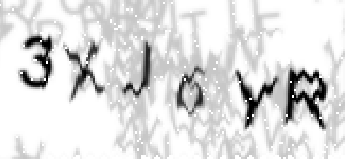 |  |
For binarization, we use an adaptive binarization algorithm, in which for each pixel (or regions of pixels) its own binarization threshold is defined [ Adaptive binarization ].
Examples of binarization:
| A good example of segmentation (3XJ6YR) | An example of glued and broken characters (4TAMMY) |
|---|---|
 |  |
To search for characters in the image, it was decided to use the method of searching for connected areas, which in Matlab can be done using functions:
CC = bwconncomp(imBin); bb = regionprops(CC, 'BoundingBox'); After that, analyze the areas obtained, select the largest of them, if necessary, break into subregions (in the case of glued characters). The case when gaps appear in the characters is not provided.
Examples of the final result of segmentation:
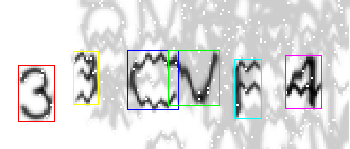 | 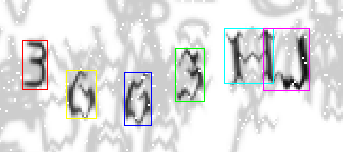 | 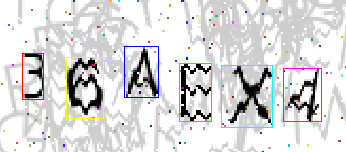 |  |  |
The quality of the segmentation is satisfactory, proceed to the next stage.
Stage 2. Creating a training sample
After segmentation, we get a set of coordinates of rectangles that are supposedly contain captcha symbols.
Therefore, we first manually recognize all captis and rename them (at that moment I felt like a professional captcha discerner, it’s a pity that I didn’t pay 1 cent for each recognized one). Then use the following script to form a training sample:
Script to create a training sample
%CreateTrainSet.m clear; clc; workDir = '.\captch'; fileList = dir([workDir '\*.png']); N_SYMB = 6; SYMB_W = 18; %px SYMB_H = 28; %px WIDTH = 166; %px HIGH = 75; %px SAVE_DIR = [workDir '\Alphabet']; %process data for CC = 1 : length(fileList) imName = fileList(CC).name; recognizedRes = imName(1:N_SYMB); %open image [cdata, map] = imread( [workDir '\' imName] ); %change color mode if ~isempty( map ) cdata = ind2rgb( cdata, map ); end %resize image cdata = imresize(cdata, [HIGH WIDTH], 'lanczos3'); %find all symbols on image rects = segmentator(cdata, N_SYMB, 1); if rects{1} == -1 continue; end %imcrop and save if length(rects) == N_SYMB if ~exist(SAVE_DIR) mkdir(SAVE_DIR); end for j = 1 : N_SYMB if ~exist([SAVE_DIR '\' recognizedRes(j)]) mkdir([SAVE_DIR '\' recognizedRes(j)]); end imList = dir([SAVE_DIR '\' recognizedRes(j) '\*.jpg']); newname = num2str(length(imList) + 1); nameS = floor(log10(length(imList) + 1)) + 1; for z = nameS : 4 newname = ['0' newname]; end tim = imcrop(cdata, rects{j}); if ( size( size(tim), 2 ) > 2 ) tim = imadjust(rgb2gray(tim)); end tim = imresize(tim, [SYMB_H SYMB_W], 'lanczos3'); imwrite(tim, [SAVE_DIR '\' recognizedRes(j) '\' newname '.jpg']); end end end After creating the sample, you need to clean it of the wrong characters that appear due to inaccurate segmentation.
An interesting fact is that the captcha uses only 23 Latin characters.
Training sample is present in the materials attached to the article.
Stage 3. Neural network training
Neural Network Toolbox is used to train the neural network.
The learning function is described below:
Creation and training of a neural network
function [net, alphabet, inpD, tarD] = train_NN(alphabet_dir, IM_W, IM_H, neuronC) %inputs: % alphabet_dir - path to directory with alphabet % IM_W - image width % IM_H - image height % neuronC - count of neuron in hidden layer %outputs: % net - trained net % alphabet - net alphabet % inpD - input data % tarD - target data % % Vadym Drozd drozdvadym@gmail.com dirList = dir([alphabet_dir '\']); dir_name = {dirList([dirList(:).isdir]).name}; alphabetSize = length(dir_name) - 2; try a = load([alphabet_dir '\' 'trainData_' num2str(IM_W) 'x' num2str(IM_H) '_.dat'], '-mat'); catch end try target = a.target; inpData = a.inpData; alphabet = a.alphabet; catch for i = 3 : length(dir_name) alphabet(i - 2) = dir_name{i}; imgList = dir([alphabet_dir '\' alphabet(i - 2) '\*.jpg']); t_tar = zeros(alphabetSize, length(imgList)); t_tar(i - 2,:) = 1; for j = 1 : length(imgList) im = imread([alphabet_dir '\' dir_name{i} '\' imgList(j).name]); im = imresize(im, [IM_H IM_W], 'lanczos3'); %resize image im = imadjust(im); im = double(im) /255.0; im = im(:); if i == 3 && j == 1 inpData = im; else inpData = [inpData im]; end end if i == 3 target = t_tar; else target = [target t_tar ]; end end end %create and train NN toc min_max = minmax(inpData); habrNN = newff(min_max, [IM_H * IM_W neuronC 23], {'logsig', 'tansig','logsig'}, 'trainrp'); habrNN.trainParam.min_grad = 10E-12; habrNN = train(habrNN, inpData, target); display('Training time:'); timeE = toc; display(timeE); net = habrNN; inpD = inpData; tarD= target; save([alphabet_dir '\' 'trainData_' num2str(IM_W) 'x' num2str(IM_H) '_.dat'], 'inpData', 'target', 'alphabet'); end The following neural network architecture is chosen:

The size of the images arriving at the input of the neural network is 10 * 12 pixels. As it is known, training of a neural network is not easy, because it is not immediately known what the network architecture should be, the number of neurons in each of the layers, and it is not known which of the many minima the training of the network rolls down. Therefore, training was conducted several times, after which one of the best results was chosen.
Stage 4. Algorithm Testing
The following script was written for testing the algorithm:
The script for captcha recognition
%% captchReader.m clear; close all; clc; cdir = './captch/'; fileList = dir([ cdir '\*.png']); load('49_67_net.mat'); load('alphabet.mat'); N_SYMB = 6; SYMB_W = 10; SYMB_H = 12; WIDTH = 166; %px HIGH = 75; %px SHOW_RECT = 1; %1 - show rects, else - don't show correct = 0; %correct recognized results correctSymbC = 0; allSymbC = 0; for CC = 1 : length(fileList) imName = fileList(CC).name; %open image [cdata, map] = imread( [cdir '\' imName] ); %change color mode if ~isempty( map ) cdata = ind2rgb( cdata, map ); end %resize image cdata = imresize(cdata, [HIGH WIDTH], 'lanczos3'); display(CC); if ( size( size(cdata), 2 ) > 2 ) cdata = imadjust(rgb2gray(cdata)); end rects = segmentator(cdata, N_SYMB, 0); if SHOW_RECT imshow(cdata); for i = 1:length(rects) colors = {'r', 'y', 'b', 'g', 'c', 'm'}; rectangle('Position', rects{i}, 'EdgeColor', colors{i}); end end if rects{1} == -1 continue; end %recognize recognized = zeros(1, N_SYMB); if length(rects) == N_SYMB for j = 1 : N_SYMB tim = imcrop(cdata, rects{j}); %resize image tim = imadjust(imresize(tim, [SYMB_H SYMB_W], 'lanczos3')); res = net(tim(:)); [sort_res, idx] = sort(res, 'descend'); recognized(j) = alphabet(idx(1)); end end correctSymbC = sum( (recognized - imName(1:6)) == 0); allSymbC = allSymbC + N_SYMB; if strcmp(recognized, imName(1:6)) correct = correct + 1; end if SHOW_RECT title(['Recognize: ' recognized]); end end fprintf('CAPTCH precision is: %2.2f %%', 100 * correct / length(fileList)); fprintf('Symbol precision: %2.2f %%', 100 * correctSymbC / allSymbC); Recognition examples:
 |  |
 | 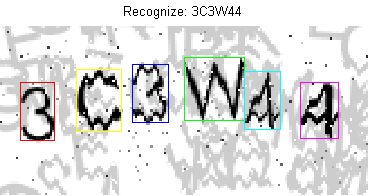 |
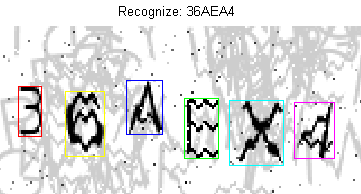 |  |
As a result, we obtained the following results:
Number of correctly recognized captchas: 49.17%
Number of characters recognized correctly: 87.02%
findings
As it turned out the captcha is not very complicated and is easily cracked. For its complication, it is necessary to use more intersections of symbols, as well as their different number.
To improve the current recognition quality, you can make the following improvements:
- improve the segmentation algorithm (for example using a histogram)
- increase the training sample
If you liked the article, in the next one I can tell you in detail about the main approaches to the recognition of a human face.
Sample Tutorial Sources
Sources Dropbox
Yandex People
Source: https://habr.com/ru/post/161159/
All Articles